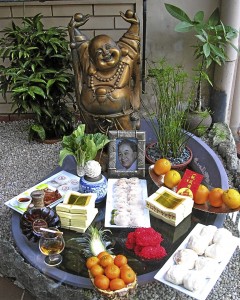
Food offerings for our dearly departed, or alay, have always roused my curiosity. Growing up, I would marvel at the mausoleums of Chinese families, with abundant food, a colorful feast carefully laid out before the beautifully painted portraits of the departed.
I asked a geomancer, “master” Aldric Dalumpines, and my Filipino-Chinese friends about the ritual of alay.
“It’s significance is to revere, pay respects and send good tidings to the departed,” says master Aldric.
“Offering them food in the afterlife brings blessings to the offerer by virtue of kindred help, sort of an intuitive form of guidance from the legacy of one’s ancestors, their virtues and values, especially in day-to-day decision-making. Simply put, it is how to make a better life, drawing from the lessons of the life of the deceased.
“It is no different from saying prayers for the dead in the Catholic faith. In feng shui or Chinese ancestral worship, it is materially expressed using lucky food offerings.
“These rituals can be done regularly, depending on the descendant. The priority must be the dead’s favorite food and drink.
It is believed that performing such rituals brings blessings to the descendants making the offering, particularly monetary blessings.
Urban lore has it that a taipan offers burnt money offerings in the amount equal to six 6-by-6 trucks monthly. Which is why, they say, his wealth is so abundant. This makes this practice a coveted way to celebrate the life of the dead ancestor.
According to the belief, the food offering must be in a lucky number and color combinations, an offering of eight oranges symbolizes double prosperity. Orange is like gold, or kim in Chinese, while 8 is faat, or riches and doubling prosperity.
“Other lucky food offerings include: sweet dumplings in the shape of guan pos, or gold money ingots of old china, a symbol of money and prosperity; kiat-kiat, or mini oranges, also symbolize gold; pork asado cuts symbolize abundance; rice ampaw or crispies are offered in figure 8 to herald rising prosperity and luck and protection from evil if colored red; sweet, steamed round sticky rice cakes in fives symbolize balanced-rising prosperity and also represents the five elements of wood, water, metal, fire and earth; lettuce or pechay offerings symbolize growth and blooming prosperity; the pineapple symbolizes ong lai, or welcoming prosperity; fish is often offered to symbolize abundance of cash in the afterlife.
“What should not be served, however, are noodles for long life,” for the obvious reason that “it no longer applies.”
According to Dalumpines, the custom of food offerings has become a subject of myth, folklore and superstition, so to each family his own, following what each has grown accustomed to.
Melanie Chua shared tips on how to prepare the perfect alay.
Fish, meat and poultry should be sliced or chopped, not offered whole, simply because the dead don’t have spoons and forks.
Do away with the bones simply to make the food easy to eat!
We also don’t offer pears. Master confirmed it is because pears and pomelo are symbols of long life.
Kelly Lee adds that fruits in bunches are generally off the menu—such as grapes and lanzones. Guava is also a taboo on any alay table. This is because “the bunching and, in the case of the guava, the many seeds promote too much childbearing in the clan, both legitimate and illegitimate.”
Kelly says the best time to make an offering is before noon. But Master qualified that in feng shui, the time and day must be in sync with the fortune calendar or Chinese almanac, Tong Shu.
Lee says they show respect and reverence for the dead by lighting incense sticks. Master points out that smoke from the incense sends heavenward the emotional messages of those making the offering.
When the incense sticks are almost consumed, “it is time to burn the paper money offerings. Then the relatives and friends can partake of the alay,” says Kelly.
However, some people believe food offerings should not be eaten for a certain duration, in honor of the dead.
I asked Master to arrange an alay table to make the lesson more visual. He said, let’s make one for your dad.
He arrived with fruits, an assortment of things to eat and kim, or paper money. We then went around our house, looked for things that my dad loved.
After arranging the food, he asked what dad enjoyed drinking, so we took out a bottle and, of course, we had to look for a cigarette—how dad loved to smoke! (That, unfortunately, caused his demise.)
Preparing dad’s alay table was an activity filled with laughter, which is what usually happens when you’re around Aldric. He uttered, aba, this is how an alay should be made—with a light and happy heart; it is, after all, to celebrate your dad’s life.
It really did feel like an act of thanksgiving. Dressing up the table made me happy, only because we were doing it for him.
When we were finally done setting it, Master said, “Ang saya na ng daddy mo. He already ate all of that in heaven!”
Suddenly, I felt tears roll down my cheeks. I really miss my dad… Now I know the ritual, in simplest terms, is, above all else, an expression of gratitude and an offering of love.
To reach and get master Aldric’s pamphlet—MyHiwagang Go La Salle Feng Shui GreenBook, a must-read also for Ateneans and Filipinos—an “edutainment” feng shui template for the living, visit www.punsoy.com.
For a copy of my new Holiday cooking class schedules, call 0917-5543700, 0908-2372346, 4008496, 9289296

